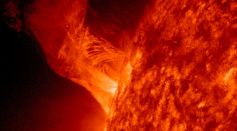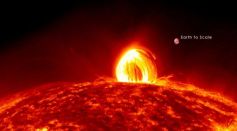Tags: Sun
Proxima Centauri Spits Out Biggest Solar Flare, But Experts Still Consider It a Habitable Region

Solar Cycle Affects Emissions of Potentially Hazardous Particles, Source Unveiled
Huge Solar Flare Captured Erupting from Sun's Surface in New NASA Video

Did NASA Just Discover a Magnetic Field in Sun’s Chromosphere?

Eating Grapes Can Make Your Skin Look 10 Years Younger, According to Study
NASA Found Sunspot Opening on the Surface of the Sun Which Could Spark Solar Flare

Arranged Nanoblocks Help Improve Solar Cell Efficiency

NASA Parker Solar Probe Spacecraft Will Finally Go the Sun To Take a Photo of Six Planets

ESA Shares Stunning New Video Showing Solar Orbiter's View of Mars, Earth and Venus

Will China 's Space Programme Launch First Mission to Sun in 2022?
NASA Detects Stunning Structures Behind Solar Winds
Solar Orbiter Spacecraft Reaches Nearest Approach to Venus
Using a Single Image, Scientists Changed People’s Insight of the Sun

3 Little-Known Facts About Neutrinos, aka, “The Ghost Particle”

How To Tell Time Without Using Clocks
Large Sunspot Arrives in Time for Thanksgiving

‘Dim the Sun’ to Save the Earth. Would It Work?
Solar-Powered Space Rocket Might Become Possible for Interstellar Travel Soon
Moon Photobombs the Sun in Stunning View From NASA Solar Dynamics Observatory
What is the Solar Cycle 25?
Most Popular

Microplastics Are Everywhere — How Plastic Pollution Threatens Wildlife, Soil, and Water

Brain Health Aging Guide: Effective Strategies for Cognitive Decline Prevention and Lower Dementia Risk

Mitochondrial Health and Aging: How Cell Energy Drives Modern Anti-Aging Science

How Scientists Use Radio Telescopes to Search for Alien Signals Across the Universe





